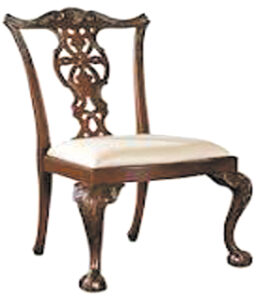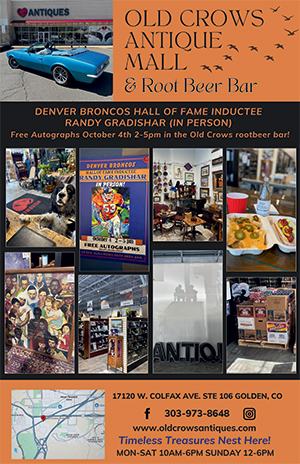 By Bobbie Sweeney
By Bobbie Sweeney Chippendale furniture was named for a famous cabinetmaker in London. In 1754, Thomas Chippendale published a book with as many as 160 designs pictured in the book. Many craftsmen at that time used his patterns, but the furniture produced was all called Chippendale, or was said to be made in the Chippendale style.
Before this, Thomas Chippendale produced elegant furniture for his fashionable clients, but his was not the finest furniture of that time. His fame came when he launched a new style in 1754, the English version of the French rococo in his pattern book. His book, A Gentleman and Cabinet-Maker’s Director, was the first illustrated catalogue published by a cabinetmaker.
His designs were based on Gothic, French and Chinese influences. Because Chippendale’s reputation stood higher than that of any other cabinetmaker, the craftsmen of the New World used his designs more fervently than any other cabinetmaker’s. When his book arrived in the 1750s, Colonial cabinetmakers combined his various designs and called the furniture Chippendale.
The Gothic influence had been an art feature in England since the Middle Ages. The most familiar are the Gothic splats on the back of the chairs, and the yoke or the top rail, which most often had a crest carved upon it.
The Georgian design and the Queen Anne design were often combined in the Chippendale chairs. The Georgian element was the pierced vase-shaped splat, and the Queen Anne splat was solid and carved with many designs. Another Queen Anne element was the hooped-shaped back with a carved cupid’s-bow crest rail and scrolled ears. The Chinese influence is seen in the bold ball-and-claw foot. However, Chippendale preferred the French foot, either turned up or turned under. The design was not quite as massive as the ball and claw. There is not one picture in Chippendale’s book of designs which show a chair with the ball-and-claw foot.
The ladder-back chair was originated by a craftsman in Philadelphia at a later date. But this chair was so well liked by George Washington that he had two dozen made for Mount Vernon.
The carved cabriole knee on the legs of a Chippendale chair was also a Chinese influence. The ball-and-claw foot and the carved cabriole knee were on most of the Chippendale-style chairs until the event of the straight legs.
The most graceful and elegant Chippendale pieces of furniture were made in Philadelphia in Colonial times, while the craftsmen in Boston and Rhode Island were more conservative in their work. The pieces were not so heavy in structure, and had less of a rococo look. The straight Marlborough legs were perfected in Rhode Island.
The cabinetmakers in London used mahogany exclusively for their furniture. But the cabinetmakers in the Colonies had always used the more abundant woods of the area—maple, walnut and cherry—before Chippendale’s book was released to them.
For awhile, merchants in the colonies imported mahogany from the West Indies and Central America. Importing the wood proved to be expensive, so to keep the dark, rich, elegant look of mahogany, the cabinetmakers used a thick veneer of mahogany over the native woods, which were cheaper to obtain.
Most chairs made in the years between 1750 and 1780 were made from the designs in Chippendale’s book. The vertical-splat back and the ladder-back, called ribbon-back, were elegantly carved. The ladder-back style, often credited to Chippendale, was actually the Georgian and Queen Anne styles used before Chippendale learned his trade.
The crest or top rail of these chairs were scrolled, and came to points or “ears” at the corners. The front legs were cabriole or straight, and the back legs were always straight. The stretchers on the legs disappeared, but most had the squared seats and rectangular backs.
All furniture made in the Chippendale style is excellently constructed and beautifully carved. When you see Chippendale furniture advertised, you know that the style originated from the designs made by the master craftsmen from London, but they are not actually the chairs made by the master himself.













Follow Us